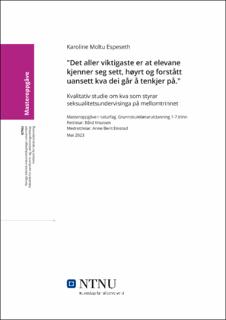| dc.contributor.advisor | Knutsen, Bård | |
| dc.contributor.advisor | Emstad, Anne Berit | |
| dc.contributor.author | Espeseth, Karoline Moltu | |
| dc.date.accessioned | 2023-07-20T17:21:56Z | |
| dc.date.available | 2023-07-20T17:21:56Z | |
| dc.date.issued | 2023 | |
| dc.identifier | no.ntnu:inspera:147333074:34495618 | |
| dc.identifier.uri | https://hdl.handle.net/11250/3080635 | |
| dc.description.abstract | Denne masteroppgåva er ein kvalitativ studie som tek for seg djupneintervju med fem lærarar, fire naturfagslærarar og ein samfunnsfaglærar. Problemstillinga er kva styrar seksualitetsundervisinga på mellomtrinnet? For å svare på denne problemstillinga har eg tatt for meg tre forskingsspørsmål; kva forståing har lærarar for seksualitetsundervising, kva styrar lærarane sine didaktiske val og korleis brukar lærarane ulike læringsressursar.
I datamaterialet kom det fram at lærarane har ulike måtar å undervise på. Alle lærarane har ein elevsentrert orientering, men dei har ulik grad av fagorientering. Nokon er meir opptatt av kva faget og læreplanen fokuserer på, medan andre ser på alternative element som viktigare. Gjennom dette fokuset på læreplanen kom det fram at nokon av lærarane tek i bruk bolkundervising. Det blir då lagt vekt på pubertet på 5. trinn, og anten ingenting eller om seksuell åtferd på 7. trinn.
Den heilskaplege tilnærminga legg bakgrunnen for drøftinga. Eg har sett på korleis lærarane stiller seg til seksualitetsundervising, opp i mot kva den heilskaplege tilnærminga legg vekt på. Den vektlegg eit heilskapleg fokus som skal famne alle aspekt ved seksualitet, kjønn og kropp; dette for å kunne gi barn best moglege liv (Støle-Nilsen, 2022, s. 18). Fagfornyinga peikar mot ein meir heilskapleg tilnærming, samt eit tverrfagleg samarbeid om seksualitetsundervising. Dette fokuset ser ein òg gjennom Snakk om det!-strategien frå regjeringa, som fokuserte på «en helhetlig innsats for å styrke hele befolkningens seksuelle helse» (Helse- og omsorgsdepartementet, 2016, s. 7).
Noko av det som var avgjerande for korleis lærarane underviste i seksualitet var læraren si kompetanse, nemleg kva syn dei har på seksualitetsundervising og kva erfaring dei sit med. Dei lærarane som hadde mindre fagorientering, viste seg å prioritere temaet i stor grad når tematikken dukka opp naturleg i klasserommet, anten det var ein situasjon dei måtte ta tak i eller spontane spørsmål frå elevane. I hovudsak brukar lærarane digitale ressursar. Dei lærebøkene dei har tilgjengelege på skulen er frå LK06. Dei brukar digitale ressursar fordi disse har oppdatert informasjon, og ein kan variere mellom ulike ressursar i større grad, gjennom tekst, bilete, video, individuelle og elevaktive oppgåver. Dei lærarane som er sterkare fagorientert hadde meir fokus på bolkundervisinga og kva tema læreplanen legg vekt på. Ein faktor her er òg at den eldre læreboka har vore styrande for kva tematikk som blir lagt vekt på. Sjølv om den eldre læreboka ikkje blir aktivt brukt i klasserommet, har den bana veg for når og kva tema som dukkar opp i seksualitetsundervisinga. | |
| dc.description.abstract | This master’s thesis is a qualitative study with in-depth interviews with five different teachers; four science teachers and one social studies teacher. The thesis research question is: What affects sexuality education in upper primary school? To answer this question, there are three research questions: What understanding do teachers have of sexuality education, what guides the teachers’ didactic choices, and lastly, how do the teachers use different learning resources?
The analysis method consists of the first step in the collective qualitative (Eggebø, 2020), and before continuing with a thematic analysis by Braun og Clarke (2022). From the data material, it became apparent that teachers have different ways of teaching. All of the teachers have a student-centered orientation but with varying degrees of subject orientation. Some are more concerned with what the subject and the curriculum focus on, while others view different elements are more important. Through this focus on the curriculum, it emerged that some of the teachers use block teaching. Emphasis is then placed on puberty in the 5th grade and either nothing or sexual behavior in the 7th grade.
The holistic approach provides the background for the discussion. I have observed how the teachers approach sexuality education, compared to what the holistic approach emphasizes. The holistic approach emphasizes a holistic focus that should embrace all aspects related to sexuality, gender and the body, to give children the best possible life (Støle-Nilsen, 2022, s. 18). The new curriculum, Fagfornyinga, aims for a more holistic approach as well as interdisciplinary collaboration on sexuality education. This is also the focus of the «Snakk om det!»-strategy from the government, which focused on «a comprehensive effort to strengthen the entire population’s sexual health» (Helse- og omsorgsdepartementet, 2016, s. 7).
A crucial part of how teachers taught sexuality was the teacher’s competence. This is due to how they regard sexuality education and what experiences they have with the matter. The teachers who were less subject-oriented prioritized the sexuality education topic to a larger extent when the topic was brought up naturally in the classroom, whether it was a situation they had to deal with or spontaneous questions from the students. For the most part, the teachers used digital resources. The textbooks that are available at their schools are from earlier curricula. Digital resources are thus used due to the updated information, which further allows for a greater variation in teaching. Text, images, video, as well as both individual and student-active tasks are available through digital resources. The teachers who are more subject-oriented had a larger focus on block teaching, and which topics the curriculum emphasized. A factor here is also that the older textbooks have been crucial for which topics are emphasized. Although the older textbooks are not actively used in the classroom, it has paved the way for when, and which, topic appears in sexuality education. | |
| dc.language | nno | |
| dc.publisher | NTNU | |
| dc.title | Det aller viktigaste er at elevane kjenner seg sett, høyrt og forstått uansett kva dei går å tenkjer på. | |
| dc.type | Master thesis | |
